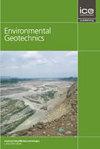hdpe砂大尺度直剪动态特性试验
IF 2.2
4区 工程技术
Q3 ENGINEERING, GEOLOGICAL
引用次数: 1
摘要
在民用项目中回收和再利用塑料废物是减少其对环境的负面影响的一种方法。高密度聚乙烯(HDPE)是一种含量很高的塑料废物,在世界范围内广泛存在并大量存在。砂土虽然具有较高的摩擦阻力,但如果改善其动力参数,则可用于比纯砂要求更高动力参数的岩土工程中。本研究旨在探讨破碎HDPE废料混合砂的动态特性及其在减轻其负面环境影响方面的应用。破碎的HDPE分别以重量的0、4%和8%加入砂中。在三种竖向应力和两种剪切幅值的作用下,进行了十次大循环直剪试验,研究了混合料的动态参数,包括阻尼和剪切刚度,并进行了讨论。结果表明:随着HDPE掺量的增加,与纯砂相比,HDPE的弹性、变形、拉伸性能和高吸能潜力使阻尼比增大,抗剪刚度减小;剪切幅值的增大降低了混合料的动剪切刚度,提高了混合料的阻尼比。本文章由计算机程序翻译,如有差异,请以英文原文为准。
Dynamic properties of HDPE-sand by large-scale direct shear experiments
Recycling and reuse of plastic waste in civil projects is one way to reduce its negative impacts on the environment. High-density polyethylene (HDPE) is a highly abundant plastic waste found widely and in high volumes worldwide. Although sand has a relatively high frictional resistance, if its dynamic parameters are improved, it can be used in geotechnical projects that require higher dynamic parameters than those of pure sand. This study aimed to investigate the dynamic properties of sand mixed with crushed HDPE waste and its application to mitigate its negative environmental impacts. Crushed HDPE was added to sand at 0, 4 and 8% by weight. Under three vertical stresses and two shear amplitudes, the dynamic parameters of the mixture, including damping and shear stiffness, were investigated by conducting a large-scale cyclic direct shear test under ten cycles and are discussed. The results showed that with increasing HDPE percentage, the damping ratio rose and the shear stiffness decreased compared with those of pure sand due to the elasticity, deformation, tensile properties and high potential of HDPE for energy absorption. Furthermore, the rise in shear amplitude decreased the dynamic shear stiffness and raised the damping ratio of the mixtures.
求助全文
通过发布文献求助,成功后即可免费获取论文全文。
去求助
来源期刊

Environmental geotechnics
Environmental Science-Water Science and Technology
CiteScore
6.20
自引率
18.20%
发文量
53
期刊介绍:
In 21st century living, engineers and researchers need to deal with growing problems related to climate change, oil and water storage, handling, storage and disposal of toxic and hazardous wastes, remediation of contaminated sites, sustainable development and energy derived from the ground.
Environmental Geotechnics aims to disseminate knowledge and provides a fresh perspective regarding the basic concepts, theory, techniques and field applicability of innovative testing and analysis methodologies and engineering practices in geoenvironmental engineering.
The journal''s Editor in Chief is a Member of the Committee on Publication Ethics.
All relevant papers are carefully considered, vetted by a distinguished team of international experts and rapidly published. Full research papers, short communications and comprehensive review articles are published under the following broad subject categories:
geochemistry and geohydrology,
soil and rock physics, biological processes in soil, soil-atmosphere interaction,
electrical, electromagnetic and thermal characteristics of porous media,
waste management, utilization of wastes, multiphase science, landslide wasting,
soil and water conservation,
sensor development and applications,
the impact of climatic changes on geoenvironmental, geothermal/ground-source energy, carbon sequestration, oil and gas extraction techniques,
uncertainty, reliability and risk, monitoring and forensic geotechnics.
 求助内容:
求助内容: 应助结果提醒方式:
应助结果提醒方式:


